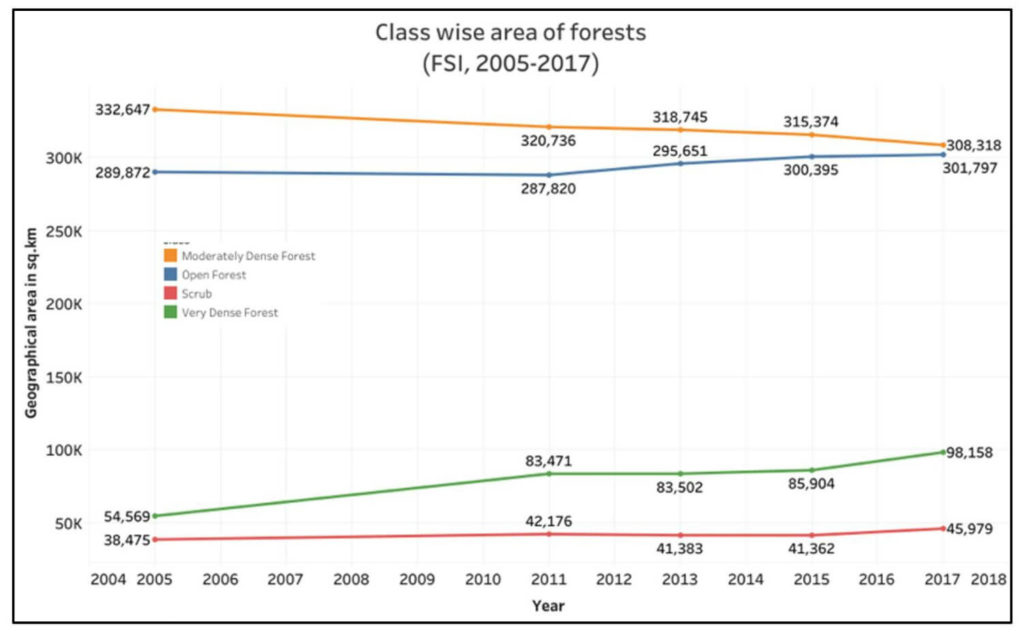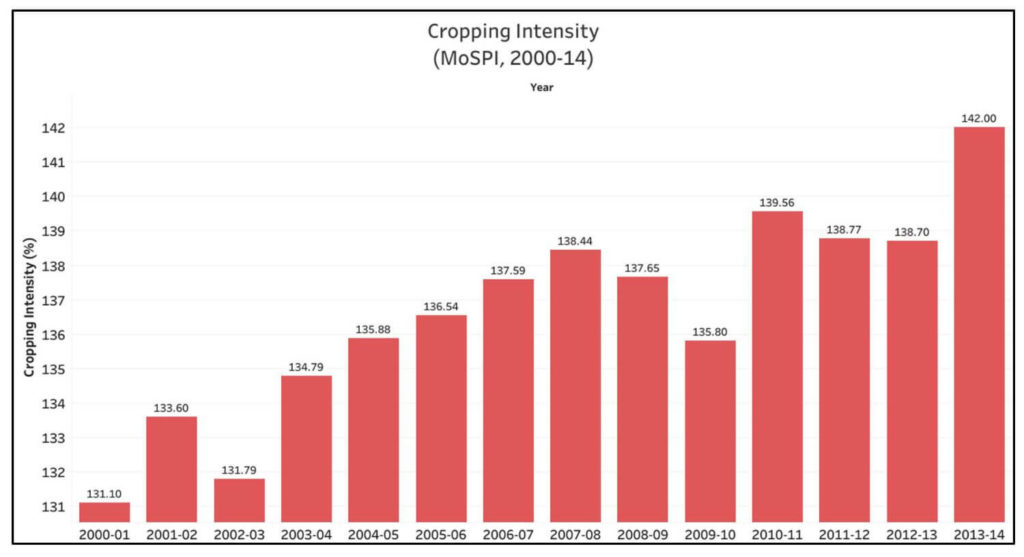[orc]A recent NASA study highlighted the increase in green cover in both India & China. But is the increase in India’s forest cover due to afforestation or increase in intensive cropping?
NASA had recently released satellite pictures and results of a study which highlights the enhanced green foliage of India and China and stated that the two of the world’s most populous countries were at the forefront in ameliorating the green cover. This is in direct contradiction to the general conception of degradation of forest resources as a result of over exploitation and large population.
As per this study, about 42% of the contribution to the green cover in China has been through the implementation of programs aimed at conserving forests and expanding them in an attempt to curb soil erosion, reduce air pollution and bring down the effects of climate change. An approximate of 32% and 82% of the difference in greenery in China and India respectively have been attributed to the intensive cultivation of food crops to feed the growing populations of the two countries. Despite there being not much of a difference in the area of land under cultivation since 2000s, both these neighbouring countries have managed to increase their green foliage as well as the food production.

While this might sound good to the ears, there are a lot of complexities around this. For instance, intensive cropping in India where the irrigation requirements for agriculture are mainly met through extraction of groundwater resources will end up in the depletion of the ground water resources. This can have serious implications on the green cover and environment in the future. In this story, we look at the data about India’s forest cover and the agriculture intensity.
Difference between Forest Cover and Forest Area
The data on forest cover & forest area is compiled by the Forest Survey of India (FSI) in the biennial Indian State of Forests Report. As per this report, ‘forest cover’ includes all the land in the country where the density of tree canopy is greater than 10% projected vertically on the horizontal ground within a minimum areal extent of one hectare. It should be noted that no distinction is made here on the grounds of land ownership, legal status and the origin of the tree crops. In other words, only the green cover is recorded in the satellite as forest cover; be it private plantations or dense foliage in private abandoned land. It also does not take into consideration those stretches of land that has been statutorily notified as forest by the government but, does not have adequate green canopy.
Forest area on the other hand is used to refer to those geographical areas of land which come under the management of the forest department such as reserved forests, protected forests and unclassified forests as mentioned under the provisions of the Indian Forest Act, 1927. This considers the legal status of the land. The categorisation made by the government is based on various factors in order to ease the governance.
India ranks 10th in the world in terms of the forest and tree cover
In terms of forest & tree cover, India ranks 10th in the world with 24.39% of the country’s geographical area under forest & tree cover. As per the government’s press release, this is despite India accounting for only 2.4% of the global surface area. Further, the press release states that the cover sustains the needs of 17% of global human population in addition to 18% of the global livestock population.
The total forest cover of India has witnessed a gradual increase since 2001. Over the span of 16 years, there has been an increase of 32,735 square kilometres, about 4.8%. While this is the case with the forest cover in the country, the extent of forest area has been wavering except for the phase from 2007 to 2011. The forest area has shot up in 2003 and came down in 2005. This discrepancy can be associated with the variation in recording of data in Karnataka. The scenario in 2013, where there has been a slight increase is because of the categorisation of more land under forest area by the forest department. There has been a sharp fall by over 7,255 square kilometres in 2015. A major contributor to this fall is Mizoram, where the land under forest area has come down from 16,717 square kilometres to 5,641 square kilometres- an abrupt decline to one third of the original area. In the same year, Mizoram faced the largest number of forest fire incidents in the country- a whopping 2,468. Madhya Pradesh has the largest forest area- 94,689 square kilometres, which constitutes 12.3% of the total forest area of the country. The same state has the largest forest cover in the country as well- 77,414 square kilometres which again contributes to a little less than 11% of the total forest cover. When expressed as the percentage of forest cover in terms of geographical area of the state, Lakshadweep tops the list with 90.33% forest cover.

The data from the FSI clearly indicates that while the forest cover has increased by around 5% in the last 17 years, the forest area has marginally reduced. This is in line with the NASA finding that the increase in green cover in India is largely due to intensive cropping.
Total forest cover of India by around 5% in the last 17 years
As per FSI, the forest cover is classified into the following on the basis of the tree canopy density:
- Very Dense Forest – All lands with tree canopy density greater than or equal to 70%
- Moderately Dense Forest – All lands with tree canopy density equal to or greater than 40% but less than 70%
- Open Forest – All lands with tree canopy density greater than or equal to 10% but less than 40%
- Scrub – Degraded forests with tree canopy density less than 10%
Non forest is another category which includes all the land that do not fall in the above categories including water.

A class wise look into the segregation of forest cover reveals that there has been a substantial increase of 79.87% in the category of Very Dense forests in the last 12 years. Even Open Forest areas and Scrub have increased by 4.1% and 19.5% respectively. Meanwhile, the area under Moderately Dense Forest has come down by 24,329 square kilometres. As of 2017, Very Dense Forests constitute 3% and Scrubs constitute only 1.4% while Moderately Dense and Open forests constitute 9.38 and 9.18 % of the total geographical area. Non forests comprise of 77.1% of the total geographic area in the country.

The total forest cover of India including mangrove forest area has increased by around 5% in the last 17 odd years and there has been proportional decrease in the total Non-Forest area.
Overall cropping intensity in India is up from 131% to 142% in 14 years
There has been a notable increase in the annual cropping intensity in India over the years, to feed the large population. The report released by NASA has also highlighted this fact.

Cropping intensity refers to the raising of a number of crops (total cropped area) from the same field during an agriculture year. In spite of the fluctuation in some years, the overall cropping intensity has gone up from 131.1% in 2000-01 to 142% in 2013-14, an increase of 10.9% in 14 years. It has to be noted that the increase in cropping intensity happened when the area under cultivation has remained more or less the same (around 140 million hectares) during this period.
About 43% of the land area in India is under cultivation. It should be kept in mind that, despite there being more agricultural land, cultivation does not take place everywhere. The production of grains, fruits, pulses etc. have increased over the years and these crops have added to the green foliage as reported by NASA.
Forests have a wide plethora of services and values associated with them, be it social, cultural, scientific or economic and therefore contribute enormously to the human population. Though the green/forest cover has increased, it has to be remembered that the loss in natural vegetation and damages inflicted upon the biodiversity and the environment still need to be looked into. The sustainability of the agriculture also remains a question mark. One of the targets of the Sustainable Development Goal 15: Life on Land aims at promoting the implementation of sustainable management of all types of forests. It also stresses on halting deforestation and adhering to measures to restore degraded forests while substantially increasing afforestation and reforestation at the global level.


